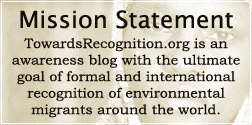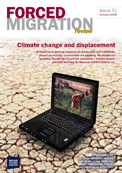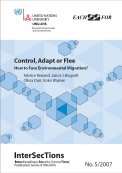Posted by Dan DaSilva on December 21st, 2009 | 
The UN Climate Change Conference in Copenhagen convened last Friday. Unfortunately, due to lack of free (and working) internet access during my visit, I wasn’t able to update the blog as often as I wanted. However, here is a roundup of the second week migration and displacement events that I attended at COP15 as well as some thoughts about the issue as a whole in relation to the entire Conference.
The draft agreement which contains the entry referring to climate change and human mobility, has not been adopted at this COP. This would be just one of the many reasons people say the talks failed. According to this document made available on the UNFCCC website, the text will continue to be worked on by Parties and further narrowed down in future climate talks. In regards to the actual paragraph itself, according to this article “many have sought to alter the passage and Australia has attempted to water it down and has requested more research.”
The “CARE and Migration” panel talk was cancelled. This was most likely due to the fact that many of the civil society observers that were supposed to be speaking at various events were not able to gain entry into the Conference venue due to logistical issues, so many ended up cancelling their trip to Copenhagen altogether.
The event “Climate adaptation continuum, migration and displacement – Copenhagen and beyond” at the Conference last Wednesday was well attended and progressive with the issue. It had a very distinguished panel and included William Lacy Swing, Director General of IOM, and António Guterres, the UN High Commissioner for Refugees. Among the issues discussed at the side event, the notion of increased illegal human trafficking and smuggling was brought up by the panel in regards to a possible continuation of lack of formal and legal recognition of climate migration. The future challenges of incorporating migration into adaptation strategies also continued to be discussed. Check out this page for a more comprehensive summary of this event.
Here is the webcast from the press conference, “UNU, UNHCR and IOM: migration/displacement and climate change” which took place last Wednesday. It seemed very rushed but many important questions from the press were addressed by the panel.
During the side events, it seemed that for every one question from the participants, there were more questions raised. Delegates from Bangladesh asked many questions and pleaded their case at every migration event I attended. They are on the front lines of climate change and for them, this was an opportunity for the people at the top to hear their voices.
Overall, the issues of migration and displacement from the effects of climate change were not addressed properly at COP15, as mitigation measures were still the predominant focus. Although climate migration and displacement is currently happening around the world, it is still fairly new on the international agenda and much remains to be done. However it is very clear that concrete action is needed right now in the most vulnerable and affected countries, regardless of formal recognition in a legally binding treaty.
As a side note, I also had the chance to see the documentary film “Climate Refugees” by Michael P. Nash. Although I strongly disagree with the message that climate migration is a national security threat for developed countries in which this film graphically portrays, I still think there are some good interviews and comments made as well as ways forward to help mitigate the effects of climate change.
There are a few publications that were released during or just before COP15 that you should be aware of. The first is “Climate Changed: People Displaced” by the Norwegian Refugee Council (NRC). This is an excellent thematic report which aims to raise awareness of displacement as one of the humanitarian impacts of climate change. The lead author of this report, Vikram Kolmannskog, also published the working paper “Climate change, disaster, displacement and migration: initial evidence from Africa” for UNHCR’s “New Issues in Refugee Research” series. The report presents evidence from Burundi and Somalia, which are among the most vulnerable countries in the world.
Another one is by IOM and is entitled “Migration, Environment and Climate Change: Assessing the Evidence”. The book focuses on seven key areas of research relating to the topic of migration, the environment and climate change, covering issues such as data challenges, research methods, sudden environmental and slow-onset events, and policy responses.
Lastly, here is a press release by IOM entitled “Greater efforts needed to tackle environmental migration beyond Copenhagen”, which was released on International Migrants Day on December 18, which also happened to be the last day of the Conference.
Here are a few more pics from inside Bella Center and around Copenhagen, as well as some from the side events I attended in the second week. A special shout-out to all of the readers of the blog that I had the honor to meet in person at the Conference!
We cannot display this gallery
Posted by Dan DaSilva on December 13th, 2009 | 
The first of the two-week UN Climate Change Conference has wrapped up. During the climate migration and displacement events, which were well attended, numbers and terminology continued
to be discussed and debated. Although it is widely agreed upon that drafting a new treaty to address climate migration and displacement may be the best option, it seems as though many of the delegates from the smaller Bangladeshi NGOs were pushing for status as “climate refugees” as they argue the 1951 UN Convention Relating to the Status of Refugees is dangerously looking out-of-date and should be amended.
At the “Climate Change and Migration: Transformations or Humanitarian Crises?” event at Development and Climate Days, many issues were discussed such as migration as adaptation as well as the notion of national security versus human security in the climate migration discourse. Loss of culture and identity was also discussed when talking about entire relocation of a nation such as Tuvalu.
Here is a good article from Reuters that covers the “Kiribati: Our road to Copenhagen” side event at COP15. During the event, the people of Kiribati made it apparent that they hold a disheartened attitude from the reluctant possibility of long-term relocation through the means of skilled migration programs in other countries.
This week the climate negotiations continue along with numerous other events at the Bella Center and around Copenhagen. Things will come down to the wire as negotiators from the 192 countries participating in the talks review several draft texts in order to seal a deal before heads of state, including Obama, arrive later in the week. Check out the COP15 website
for daily roundups of the negotiations as well as other related news.
Here are a few pictures from the COP15 as well as some pics from a few of the migration and displacement events I attended.
We cannot display this gallery
Posted by Dan DaSilva on November 27th, 2009 | 
Approximately 4,500 participants, including delegates from 181 countries met in Barcelona on November 2-6 to take part in the last round of the UNFCCC Climate Change Talks before the upcoming and historic UN Climate Change Conference in Copenhagen (COP15) in less than 2 weeks.
In front of them was the current revised version of the draft agreement (negotiating text) which was to be further streamlined and narrowed down for a possible international deal on climate change adaptation, mitigation, financing, and technology transfer. The text which came out of the session has recently been publicly released on the UNFCCC website.
The two entries in the “Adaptation” section relating to human mobility have been unbracketed from the previous draft texts, which means it has been agreed on to be included in the current 174-page text to be finalized at COP15. The first entry is found on page 38, paragraph 12(c) and reads as follows:
12. To enhance adaptation action at international level, all Parties [shall] [should] [may] implement specific programmes, projects, activities, strategies and measures, including:
…
(c) Activities related to national, regional and international migration and displacement or planned relocation of persons affected by climate
change, while acknowledging the need to identify modalities of inter-state cooperation to respond to the needs of affected populations who either cross an international frontier as a result of, or find themselves abroad and are unable to return owing to, the effects of climate change;
The other entry is on page 56, paragraph 13(b) and reads as follows:
13. All Parties [shall] [should] jointly undertake action under the Convention to enhance adaptation at the international level, including through:
…
(b) Activities related to migration and displacement or planned relocation of persons affected by climate change, while acknowledging the need to identify modalities of interstate cooperation to respond to the needs of affected populations who either cross an international frontier as a result of, or find themselves abroad and are unable to return owing to, the effects of climate change.
The advances made in this draft agreement from last UNFCCC talks on the recognition and protection of the rights of people who become displaced or forced to migrate due to the effects of climate change are monumental. It is now up to Parties at COP15 to determine whether this entry will remain in the final treaty, as well as being signed on to itself. Leave a comment below regarding what you think the outcome will be at COP15.
Posted by Dan DaSilva on October 24th, 2009 | 
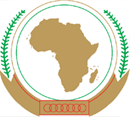 The Emblem of the AU The African Union (AU), which is an intergovernmental organization consisting of 52 African states, held the Special Summit for the Protection and Assistance of Internally Displaced Persons in Africa this week. It took place in Kampala, Uganda and concluded yesterday, running from October 19 to October 23. The theme of the summit was “Addressing the Challenge of Forced Displacement in Africa”.
The summit was a success and out of it came the adoption of the groundbreaking Convention on Protection and Assistance to Internally Displaced Persons in Africa. The Convention is the first continent-wide instrument to address the specific plight of internally displaced people. It integrates the main aspects of international humanitarian law and will oblige AU states for the first time to prevent internal displacement, come up with solutions to the causes of displacement, and provide internally displaced people with basic rights. People forced to flee will find in the Convention the full range of rights they should be entitled to – before, during and after displacement. For the Convention to enter into force, at least 15 AU member states would have to ratify it.
The Convention is also the first of its kind in many ways with regards to legitimizing increasing environmental migration and displacement. It is a legally binding regional treaty that recognizes the multiple causes of internal displacement, including natural disasters and climate change as drivers of this phenomenon. In 2008, there were 104 internationally reported natural disasters, 99 percent of which were climate related. Moreover, the number of people in Africa affected by natural disasters has doubled over the last 20 years, from 9 million in 1989 to nearly 17 million in 2008.
The actual entry relating to climate change displacement in the Convention can be found Article 5: “Obligations of States Parties relating to Protection and Assistance”, Section 4, and states:
“States Parties shall take measures to protect and assist persons who have been internally displaced due to natural or human made disasters, including climate change.”
United Nations Under-Secretary-General for Humanitarian Affairs and Emergency Relief Coordinator John Holmes was in attendance. “In reality, displacement prompted by natural disasters and climate change, and the resultant food and water shortages, promise to be one of the greatest – if not the greatest – challenge many countries will face in the years ahead,” stressed Mr. Holmes in a speech during the summit. “Many of you here today already know all too well from recent painful experiences how climate change is increasing the frequency and intensity of extreme natural-hazard events, particularly floods, storms and droughts,” he added.
The recognition of climate change as a driver of displacement in this AU instrument sends a signal to the rest of the international community, including the United Nations, about the seriousness with which Africa, home to around half of the global total of internally displaced persons, considers this issue.
Posted by Dan DaSilva on August 25th, 2009 | 
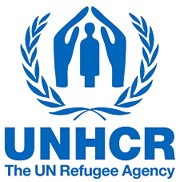 The United Nations High Commission for Refugees (UNHCR) has recently updated their policy paper entitled Climate change, natural disasters and human displacement: a UNHCR perspective, which was originally released October 2008. The 14-page paper looks at the human side of climate change, particularly the status and protection needs of those who are most directly affected. The United Nations High Commission for Refugees (UNHCR) has recently updated their policy paper entitled Climate change, natural disasters and human displacement: a UNHCR perspective, which was originally released October 2008. The 14-page paper looks at the human side of climate change, particularly the status and protection needs of those who are most directly affected.
The ongoing theme of this document is the need to encourage more research and reflection on the humanitarian and displacement challenges that climate change will generate. It opens with a quote from António Guterres, the UN High Commissioner for Refugees:
“Although there is a growing awareness of the perils of climate change, its likely impact on human displacement and mobility has received too little attention.”
The paper makes a huge advances in the recognition of environmental migrants from the October 2008 version, stating:
“While environmental factors can contribute to prompting cross-border movements, they are not grounds, in and of themselves, for the grant of refugee status under international refugee law. However, UNHCR does recognise that there are indeed certain groups of migrants, currently falling outside of the scope of international protection, who are in need of humanitarian and/or other forms of assistance.”
The paper is divided into four sections and examines the following:
1) foreseeable displacement scenarios,
2) their implications for UNHCR,
3) terminology and the 1951 Refugee Convention,
4) suggestions for the way forward.
According to the paper, UNHCR admits that it “might take some time to reach an agreement on the appropriate way forward” and “more work is needed to analyze the likely human displacement scenarios which climate change will cause, and to identify and fill any legal and operational gaps”. In the meantime, UNHCR “encourages the international community to adopt approaches based on respect for human rights and international cooperation”. UNHCR also believes that “the need for advocacy on climate change issues will remain in various fora into 2010 and beyond”.
Click here to access the policy paper »
Posted by Dan DaSilva on August 15th, 2009 | 
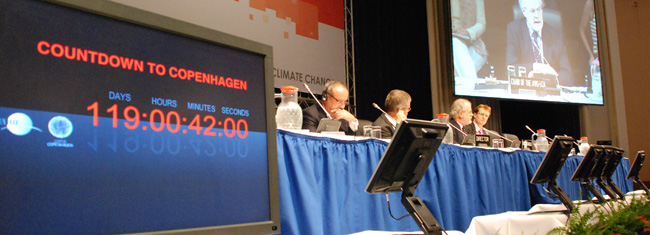 Photo credit: UNFCC Here is an update for those of you that are following the lead up to the UN Climate Change Conference in Copenhagen (COP15) this December. More than 2,000 representatives met at the latest round of the Climate Change Talks, which took place on August 10-14. The committee had the current revised version of the negotiating text in front of them, which is to be fully agreed on by COP15 in order for a post-Kyoto climate deal to take place.
There was a single sentence that was inserted in the previous version of the negotiating text proposed at the June Climate Change Talks, which relates to environmental migration. It calls on nations to implement plans to adapt to climate change by accounting for these possible migrations. This sentence was found in subparagraph 25(e) and stated at the time:
“Activities related to national and international migration/planned relocation of climate
refugees.”
Since then, subparagraph 25(e) has been updated/expanded to the following:
“[Activities related to national and international migration/planned relocation of climate
[refugees] [migrants] [displaced persons by extreme climate events].]
Alternatives to subparagraph 25 (e):
Alternative 1
[Activities related to national and international responses to people displaced by the impacts of climate change]
Alternative 2
[Activities related to national and international migration and displacement or planned relocation of persons affected by adverse impact of climate change]
Alternative 3
[Activities related to national and international migration/planned relocation of displaced individuals and peoples due to the adverse effects of climate change]”
It should be noted that every entry in the negotiating text which is contained in [square brackets] is an indication that it’s an unresolved issue. As you can see, there is still no solid agreement on this specific entry in the negotiating document. Instead, many still unagreed alternative sentences are presented.
Briefing the media on the last day of the informal consultations in Bonn, UNFCCC Executive Secretary Yvo de Boer said that while selective progress had been made to consolidate the huge texts on the table, “at this rate, we will not make it”. “We seem to be afloat on a sea of brackets”, de Boer also said, referring to not only paragraph 25(e), but also the other unresolved issues in the text.
Work on the draft negotiating text will continue on September 28 in Bangkok at a two-week session. Delegates will then assemble for five days of pre-Copenhagen negotiations in Barcelona on November 2. The UN Climate Change Conference in Copenhagen takes place from December 7-18, 2009. Do you think there will be a formal agreement made in time regarding the provision and financing mechanisms to protect people displaced by the impacts of climate change?
Related Links:
» – Examiner.com
» Gloomy Negotiators End Bonn Climate Talks – New York Times
» Closing Press Briefing, Bonn Climate Change Talks – August 2009 – YouTube video
» More From the Bonn Climate Change Talks – Towards Recognition
|
|


 The
The 
